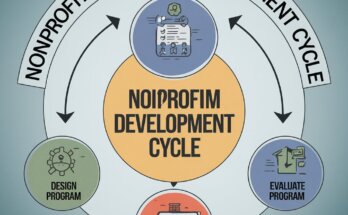When it comes to making a difference in the community, knowing how to measure nonprofit impact is key. It’s not just about feeling good; it’s about seeing real, tangible results and proving that your efforts are making a difference. But how do you actually measure impact?
Is it just numbers on a page, or is there more to it? In this post, we’re going to break down simple, effective ways to measure the true impact your nonprofit is having on the community.
Why Measuring Impact Matters
Imagine running a nonprofit for years and not really knowing if your efforts are truly changing lives. Measuring impact isn’t just about tracking progress; it’s about ensuring that every dollar spent, every volunteer hour, and every effort is creating positive change.
When you can clearly show your impact on the community, you’re not only motivating your team, but also building trust with donors and stakeholders. After all, who wouldn’t want to support a cause that can prove its success with hard data and real stories?
Key Metrics to Measure Nonprofit Impact
To measure impact effectively, you need to focus on key metrics that showcase your success. Here are some of the most common metrics that nonprofits should track:
1. Number of People Served
One of the simplest ways to measure your impact on the community is by tracking how many people your programs reach. Are you providing food to 500 families each month? Educating 1,000 children in underserved areas?
These numbers tell a story of reach and scale. However, it’s important to go beyond just the numbers.
Example: If your nonprofit runs a job training program, don’t just track how many people enrolled. Track how many of them secured jobs within six months of completing the training.
2. Outcome-Based Measurements
It’s not enough to say you’ve served a large number of people. You need to show what happened as a result. This is where outcome-based measurements come into play.
For example, if you run a literacy program, measure how many of your participants improved their reading skills after six months.
Example: A nonprofit running a mental health support program could track improvements in participants’ mental well-being by using pre- and post-program surveys. This could include changes in stress levels, anxiety, or self-reported quality of life.
3. Community Feedback
Getting feedback from those you serve can give you invaluable insights into your impact. Use surveys and focus groups to understand how your services are perceived and how they are affecting lives. The real voices of community members can provide more insight than numbers alone.
Example: After running an after-school program, a nonprofit could survey parents to learn if their children’s academic performance and social skills improved. This feedback can help shape future programming to better meet the needs of the community.
Impact That Changed Lives
Imagine a small nonprofit in rural Texas called “Bright Future Kids.” Their mission was simple—help children in low-income communities stay in school. For years, they handed out school supplies and provided after-school tutoring. But they couldn’t figure out if they were making a real difference.
One day, they decided to measure their impact more closely. They started tracking attendance rates before and after children joined the program. They asked the kids to write about how the program had changed their lives. And they spoke to teachers about changes in the kids’ behavior and performance in class.
The results were eye-opening. They found that 85% of the kids in their program attended school regularly, compared to only 60% before. Teachers shared that kids who used to struggle with reading now showed excitement about their progress. And the children’s stories about wanting to “make it to college” gave the nonprofit a deeper understanding of their true impact.
With this data, Bright Future Kids was able to secure a larger grant, expand their program, and reach even more children in need. The story of their success became their most powerful tool for attracting new donors and volunteers.
4. Long-term Outcomes
Long-term outcomes measure changes that take place over a longer period. These could be things like a reduction in homelessness in your community, improved graduation rates among students you’ve helped, or increased income levels for families that went through your job training programs.
Example: A nonprofit working to reduce homelessness might track the number of individuals who remain housed for one year after receiving support. This demonstrates that their program is providing long-term solutions rather than temporary fixes.
5. Cost-Effectiveness
Another critical way to measure impact is by assessing your cost-effectiveness. This means looking at how much it costs to achieve a particular outcome. For example, how much does it cost your organization to move one person out of poverty? Cost-effectiveness helps you optimize your resources and shows donors that their contributions are being used wisely.
Example: If it costs $500 per participant to run a job training program, but participants are able to secure jobs earning $25,000 annually, the cost-effectiveness ratio shows a high return on investment for donors and stakeholders.
Practical Strategies to Apply These Measurements
So, how do you start applying these strategies in your own nonprofit? Let’s break it down:
- Set Clear Goals: What exactly do you want to achieve? For example, if you run a youth mentorship program, your goal might be to see a 20% increase in high school graduation rates among participants.
- Use Technology for Data Collection: Tools like Google Forms, SurveyMonkey, and even simple spreadsheets can help you collect and analyze data. You don’t need a fancy system to get started—just a willingness to track your impact.
- Create a Feedback Loop: Make it easy for your beneficiaries, staff, and community members to share their feedback. Regularly check in and adjust your programs based on what you learn.
- Tell Your Story: Don’t just share numbers—share the stories behind those numbers. Stories of lives changed, challenges overcome, and hope restored are powerful motivators for donors and volunteers.
Download Your Free Resource
Ready to take your nonprofit’s donor engagement to the next level? Download the: Top 10 Donor Stewardship Strategies for Nonprofits + Free Donor Engagement Checklist. This guide will help you build stronger relationships with your donors and keep them coming back year after year.
Measuring Nonprofit Impact Beyond Numbers
While data is important, it’s not everything. Sometimes, the most powerful impact measurement comes from the stories and testimonials of those whose lives have been touched by your work. These personal stories add depth and meaning to your data, providing a fuller picture of your nonprofit’s value to the community.
6. Partnership and Collaboration Impact
Measuring the impact of partnerships and collaborations is another important aspect of understanding your reach. Are there community organizations or local businesses that you collaborate with? Track how these partnerships have expanded your reach or enhanced the quality of services you offer.
Example: A food bank partnering with local farmers to provide fresh produce can measure the increase in nutritional value of the food baskets they distribute. This demonstrates that their program not only addresses hunger but also promotes healthier living.
7. Social Media Engagement
Yes, your online presence is a form of impact! Tracking engagement on social media—like comments, shares, and messages from beneficiaries—can offer insights into how your community perceives your work and what resonates with them.
Example: A nonprofit that advocates for animal welfare might track the number of shares and comments on posts about their animal adoption drives, indicating increased awareness and community support.
8. Volunteer Impact
Don’t forget the volunteers! Tracking how many hours they contribute and the roles they fill can give you a better understanding of your volunteer program’s success. Even more, you can measure the skills gained by volunteers through their service.
Example: If your nonprofit offers training for volunteers working in domestic violence shelters, track how many volunteers gain certification or new skills that they can use in future careers.
Final Thoughts:
Measuring impact might seem overwhelming, but it doesn’t have to be. Start small, track what you can, and grow from there. With each step, you’ll gain more clarity about how your nonprofit is changing lives and making your community a better place. And remember, it’s not just about the numbers—it’s about the stories that make those numbers come alive.
Ready for More Nonprofit Tips?
If you found this guide helpful, don’t forget to subscribe to the Nonprofit Navigators Newsletter. We share expert tips, resources, and strategies to help your nonprofit thrive. Let’s keep building a better world, one step at a time!




